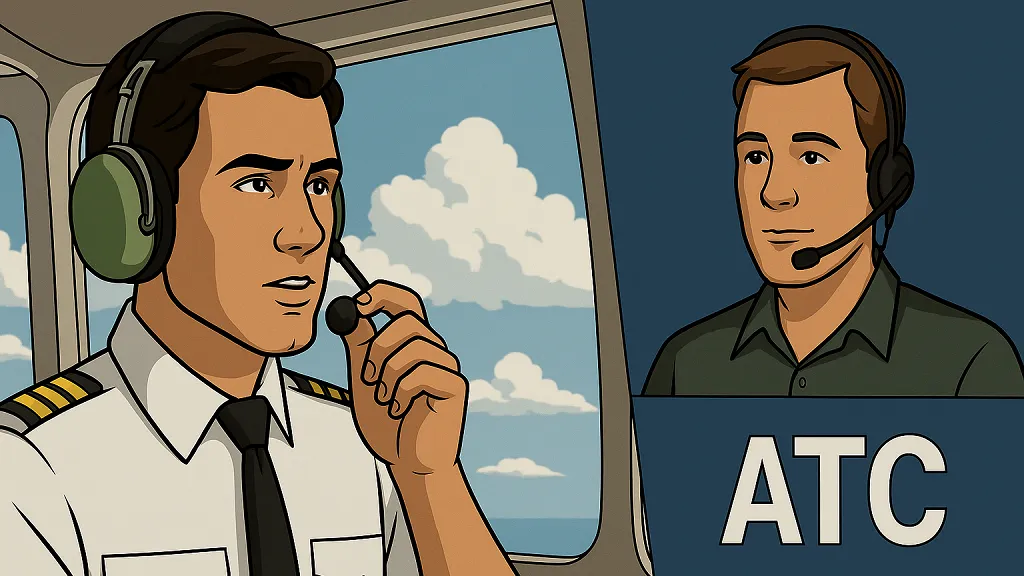Clear, concise, and professional communication with Air Traffic Control (ATC) is one of the most vital skills any pilot can master. For both student pilots and experienced aviators, effective pilot-controller dialogue ensures safety, efficiency, and situational awareness throughout every phase of flight. Following, we’ll break down multiple real-world ATC communication scenarios, explain the reasoning behind each exchange, and provide actionable tips you can apply to improve your communication proficiency.
We’re going to cover:
- Ground Control and Taxi Instructions
- Clearance Delivery and Flight Plan Coordination
- Tower Vectoring and Approach Control Communications
- En Route Center Communications and Handoffs
- International Flight Communications and Oceanic Procedures
- Emergency Declarations and Priority Handling
By the end, you will have a clear framework for mastering ATC communication at every stage of your aviation journey. So, buckle up and let’s get into it.
1. Ground Control and Taxi Instructions
Ground control communications begin the moment your aircraft leaves the parking ramp and continues until takeoff clearance. Miscommunication on the ground can lead to runway incursions, traffic conflicts, and unsafe situations. This phase requires high situational awareness, especially at busy airports with complex taxiway layouts.
Key Elements of Ground Control Communications
- Receive and read back taxi clearances accurately.
- Use your call sign in every transmission.
- Request progressive taxi instructions if unfamiliar.
- Always monitor ground frequency until switching to tower.
Example
Ground: “N123AB, taxi to Runway 26L via Alpha, Bravo, hold short of Runway 26R.”
Pilot: “Taxi to Runway 26L via Alpha, Bravo, hold short of Runway 26R, N123AB.”
Tips for Success
- Always have an airport diagram ready.
- Review NOTAMs for taxiway closures.
- Ask for clarification if instructions are unclear.

2. Clearance Delivery and Flight Plan Coordination
Clearance delivery is typically your first radio call before departure, particularly for IFR flights. It ensures your route, altitude, and departure procedures are properly coordinated before you even move the aircraft.
Key Elements of Clearance Delivery
- Read back clearances verbatim.
- Verify your departure frequency and transponder code.
- Confirm any route amendments.
Example
Clearance: “N123AB, cleared to Denver via the Phoenix Six Departure, climb and maintain 5,000, expect 12,000 in 10 minutes, squawk 4321, departure frequency 123.85.”
Pilot: “Cleared to Denver via Phoenix Six Departure, climb and maintain 5,000, expect 12,000 in 10 minutes, squawk 4321, departure on 123.85, N123AB.”
Tips for Success
- Write down your clearance before reading it back.
- File your flight plan well in advance.
- Monitor for potential route changes due to weather or traffic.
3. Tower Vectoring and Approach Control Communications
Tower vectoring and approach control play a crucial role during arrival, departure, and approach phases. Controllers assign headings, altitudes, and speeds to maintain separation and organize traffic in congested terminal areas.
Key Elements of Vectoring Communication
- Read back all altitude and heading assignments.
- Notify ATC immediately if unable to comply.
- Maintain situational awareness during vectors.
Example
Approach: “N123AB, turn left heading 270, descend and maintain 3,000.”
Pilot: “Left heading 270, down to 3,000, N123AB.”
Tips for Success
- Review sectional charts for terrain awareness.
- Stay ahead of the aircraft by anticipating next instructions.
- Use your autopilot when appropriate to reduce workload.
Understanding Complex Airspace
4. En Route Center Communications and Handoffs
Once airborne and away from terminal airspace, en route center controllers manage high-altitude traffic. They handle frequency handoffs, altitude changes, and weather deviations, ensuring safe and efficient cruise flight.
Key Elements of En Route Communication
- Listen carefully during handoffs.
- Promptly report altitude changes.
- Request weather deviations early.
Example
Center: “N123AB, contact Albuquerque Center on 134.65.”
Pilot: “134.65, N123AB.”
Tips for Success
- Always monitor the assigned frequency for updates.
- Be ready to relay position and intentions during deviations.
- Monitor other traffic for situational awareness.
5. International Flight Communications and Oceanic Procedures
International and oceanic operations involve complex procedures, especially in areas beyond radar coverage where position reports are required. This level of communication demands additional training and preparation.
Key Elements of International Communications
- Use proper position reporting format.
- Follow oceanic clearances precisely.
- Be proficient with HF and SATCOM procedures.
Example
“Shanwick, N123AB position report: 50N 020W at 1300Z, flight level 350, estimating 51N 030W at 1345Z.”
Tips for Success
- Review international flight procedures before departure.
- Monitor emergency frequencies.
- Carry backups for long-range communication failures.

6. Emergency Declaration and Priority Handling
Emergencies require immediate, clear communication using internationally recognized distress calls. Knowing how to declare an emergency properly can be lifesaving.
Key Elements of Emergency Communication
- Use “Mayday” for distress and “Pan-Pan” for urgency.
- State the nature of the emergency, souls on board, and fuel remaining.
- Follow ATC instructions precisely.
Example
“Mayday, Mayday, Mayday, N123AB, engine failure, 3 souls on board, 45 minutes of fuel remaining, requesting immediate landing clearance.”
Tips for Success
- Remain calm and professional.
- Practice emergency scenarios during recurrent training.
- Always review weather conditions that may affect emergency handling.
ATC Communication Scenarios Summary Table
| Scenario | Complexity | Primary Focus | Key Tools |
|---|---|---|---|
| Ground Control | Moderate | Taxi instructions, runway safety | Airport diagrams |
| Clearance Delivery | Moderate | Route planning, altitude, squawk | Flight plan accuracy |
| Tower Vectoring | High | Approach/departure separation | Radar, autopilot |
| En Route | High | Traffic management, handoffs | Data link, center controllers |
| International/Oceanic | Very High | Position reporting, oceanic clearances | HF radio, SATCOM, CPDLC |
| Emergency Handling | Highest | Immediate response, clear communication | Standardized phraseology |
Developing Effective ATC Communication Habits
Clear, professional communication requires consistency and attention to detail. Here are the best habits to build:
- Use proper phraseology every time.
- Maintain active listening skills.
- Stay mentally ahead of the aircraft.
- Rehearse communication procedures regularly.
- Seek feedback from instructors and fellow pilots.
Why Mastering ATC Communication Is Essential
Strong ATC communication directly supports flight safety, efficiency, and operational confidence. It reduces workload, enhances situational awareness, and ensures pilots and controllers work as a coordinated team. Effective radio skills are just as important as stick-and-rudder skills for safe and successful flight operations.
For student pilots, studying real-world ATC communication examples builds confidence early. For licensed pilots, consistently refining these skills ensures sharpness in every flight phase.
Frequently Asked Questions (FAQs)
What is ATC communication?
ATC communication refers to the radio transmissions between pilots and air traffic controllers that coordinate flight operations, ensure safety, and manage traffic flow through all phases of flight.
Why is clear communication with ATC important?
Clear and concise communication helps prevent misunderstandings, runway incursions, airspace conflicts, and other safety risks. It ensures that both pilots and controllers share accurate information for safe and efficient operations.
What are the basic phases of ATC communication?
The primary phases include ground control, clearance delivery, tower vectoring, en route communications, international procedures, and emergency handling.
What should pilots say during an emergency?
Pilots should declare “Mayday” for life-threatening emergencies or “Pan-Pan” for urgent but non-life-threatening situations. They should clearly state the nature of the emergency, souls on board, and fuel remaining.
How can student pilots practice ATC communication?
Student pilots can practice through flight simulation, role-playing with instructors, listening to live ATC feeds, and reviewing real-world communication examples to build confidence and proficiency.
Is phraseology the same worldwide?
While ICAO standardizes much of the phraseology internationally, some regional differences still exist, especially in non-English speaking countries or during oceanic operations.
Do VFR pilots need to communicate with ATC?
VFR pilots may need to communicate with ATC when operating in controlled airspace, around Class B or Class C airports, or when requesting flight following.
How does international ATC communication differ?
International communication often involves additional procedures such as position reports, oceanic clearances, HF radio usage, and coordination between multiple air traffic control authorities across borders.
Recent Posts
FAA MOSAIC Final Rule: What Pilots, Manufacturers, and the Aviation Community Need to Know
Learn how the FAA’s MOSAIC final rule revolutionizes Light-Sport Aircraft certification, expands Sport Pilot privileges, and reshapes general aviation. See what’s changing, when it takes effect,...
Student Pilot Insurance: Essential Coverage for Aspiring Flyers
Discover how student pilot insurance can protect your flying dreams. Get expert tips and coverage options to ensure your safety and peace of mind.


